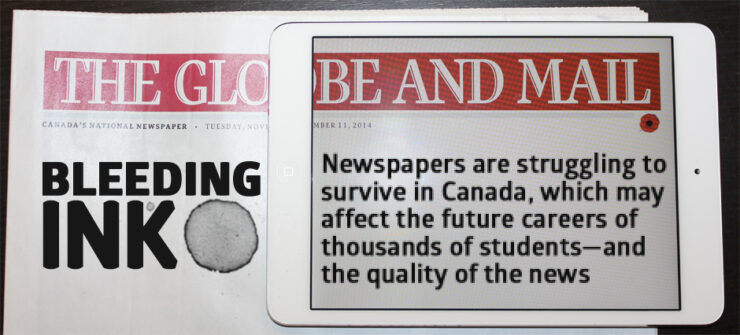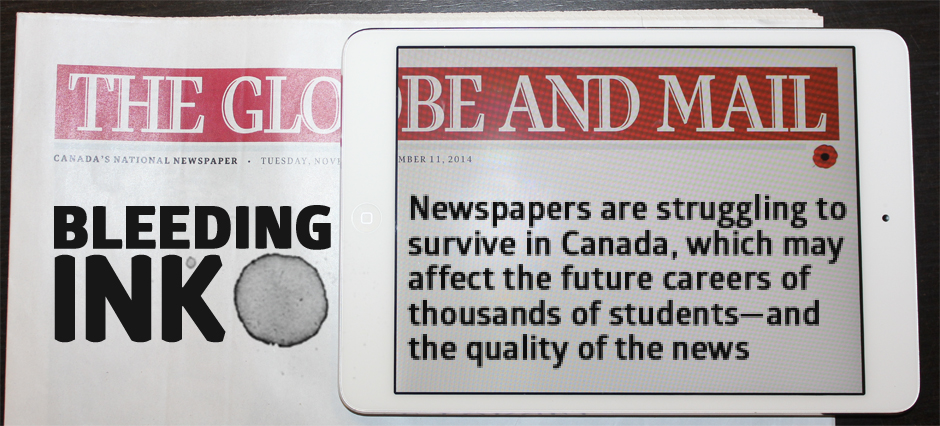Newspapers may not exist in 5 years—that’s how dire the current situation is for print media in Canada and the United States.
Last year, the New York Times Company (NYTCo) sold the Boston Globe for $70 million, 20 years after it purchased the paper for a record $1.1 billion. According to Slate, this sale actually cost NYTCo money, as the company still owes the Globe $110 million in pensions. This for a publication that produced 11 Pulitzer Prize winners since its sale to NYTCo in 1993.
Newsweek, once the second-largest weekly news magazine south of the border, was sold in 2010 for one dollar. It subsequently was sold again for an undisclosed amount in 2012, but cancelled its print edition that October after its then editor Tina Brown declared the publication had “reached a tipping point at which we can most efficiently and effectively reach our readers in all-digital format.”
Newsweek re-launched its print edition this year, but the editor’s words strike at the heart of the current issue for print news publications—their centuries-old business model is broken.
Canadian news publications haven’t been immune to print media’s struggles either. According to a report by Communications Management Inc., total paid daily newspaper circulation in Canada per household decreased from 44 per cent in 2000 to 27 per cent in 2012. During that same time frame, total classified advertising revenue diminished from more than $800 million per year to less than $300 million.
Torstar Corporation, the company in charge of the Toronto Star, Hamilton Spectator, Guelph Mercury, and 100 other community newspapers, reported a net loss of $87 million from continuing operations in the third quarter of this year, compared with a loss of $80.2 million in the same quarter last year.
In early October, Postmedia—the owner of the National Post, the Ottawa Citizen, and many other city newspapers across Canada—announced plans to purchase Sun Media’s 175 English-language papers across the country for $316 million.
The dollar amount is significant, yet a deal between our country’s two largest newspaper chains would’ve caused alarm two decades ago, as it dangerously puts the destiny of Canada’s print industry much deeper in the pockets of one company. The same company who, during the fourth quarter of 2013, said operating losses deepened to $35.8 million, compared to a loss of $28.4 million in the same quarter a year earlier.
Here I made a Canadian media ownership chart for everyone to help put Postmedia/Sun Media deal in context. pic.twitter.com/IBUz449baK
— Steve Ladurantaye (@sladurantaye) October 6, 2014
This may all seem like the unfortunate but unavoidable price of progress in our profit-driven economic system. But the repercussions of the industry’s downfall may have severe consequences for the quality and range of the news that Canadians are exposed to, and for the future careers of thousands of student journalists.
Lost in the digital age
The problem news organizations face today is that the advertising model that sustained print media for decades does not translate to the digital realm. With a print product, news organizations could charge advertisers large sums of money for page space because they could assure advertisers that their readers had to look over these ads during reading. They could also rely on a high income from smaller, local advertisements in the classifieds.
But these two types of advertising logic don’t work in the digital age. Consumers can now click on the specific articles they are interested in, making full-page advertisements defunct. Free classified services like Kijiji and Craigslist have made paid classifieds in newspapers almost useless—when was the last time you looked for a job or tried to sell a textbook in a newspaper?
Faced with this massive advertising dilemma, news organizations have mostly chosen to attack the problem through the lens of their previous experience. Print media has attempted to use pop-up and banner advertisements as an alternative to the selling of page space. The idea is the same: Force the reader to look at ads while they read content.
But even this has been undermined by the advent of ad-blocking software. The number of clicks an article receives online does not ensure that all these people have seen the accompanying ads, making it a hard sell for news providers to charge the same prices to advertisers as they would in print.
Even more challenging for news organizations is targeted online advertising. Companies that collect data on user habits and demographics, such as Google or Facebook, can offer companies cheaper advertising options that target a specific audience. A university advertising on Facebook can ensure its advertising is seen only by 18-20-year-olds, while a media provider can only offer advertising opportunities with content aimed at an approximate demographic.
The other important stream of revenue for print media is sales, a stream that in the realm of the Internet is almost impossible to enforce. News organizations have attempted to combat this problem with paywalls that, following the logic of print subscriptions, charge customers a monthly or yearly fee for access to content.
Although there’s some debate over the topic, paywalls are largely ineffective because readers, when faced with a cost, will simply go elsewhere online for news that is free. Online paywalls have only proven to be effective if the content or quality of content being offered cannot be found elsewhere, a fact that explains why a premium newspaper like the New York Times, with a reputation for unmatched quality, has found them quite profitable, while another like the Toronto Star has not. In fact, the Toronto Star has announced plans to drop its paywall in 2015.
Alexandra Homolar, a constructivist scholar of international politics, articulated the same type of faulty logic in her analysis of state military spending in response to the end of the Cold War. Homolar argued that actors interpreting cataclysmic changes to their environment are more likely to interpret these events “through the prism of actors’ previous experiences, existing policy goals and cognitive frameworks.”
In other words, news organizations created and shaped in a previous business model are less likely to be able to adapt to the digital era compared to organizations that were developed in the new environment. Such an analysis explains how a low-cost viral news organization like BuzzFeed, founded in 2006, was able to project $120 million in revenue for 2014.
Changing the very nature of news
Pierre Bélanger, a professor in the University of Ottawa’s department of communication, spoke to the Fulcrum about the future of print media. He said the struggles of the industry may have larger consequences than merely the bankruptcies of a few legacy news organizations: They may affect the quality and depth of the news Canadians receive.
“There’s a very, very serious threat because news agencies have become money-making machines,” said Bélanger.
“They’re not really news entities as sort of the ritual that people love having on their coffee table in the morning, or on the bus. Buying a newspaper for the sake of in-depth journalism or think-pieces—very few of our dailies in the country now can claim that function.”
He said investigative journalism in Canada is on its way out because more viably profitable areas of news, such as scandals like the Rob Ford saga or the unfolding Jian Ghomeshi story, are what readers have demonstrated they want to spend money on.
“It’s like running a Tim Hortons concession. What flavour do you prefer in your coffee? What flavour do you prefer for your doughnuts? That’s what I’m about to bake or brew,” he said.
Another consequence of news organizations’ struggles is that there may be a less diverse range of insights and analysis on topics because there will simply be fewer reporters employed to cover stories.
For example, what if Postmedia, soon to be the owner of both the Ottawa Citizen and the Ottawa Sun, decides it’s no longer profitable to keep two papers running in a city and shuts one down? That will cut the amount of local reporters covering a story in half, making the bias and reporting style of these remaining reporters more important.
Imperilling the future careers of students
According to Service Canada, the emergence of new job opportunities in the field of digital media has not compensated for job reduction in the more traditional sectors of journalism. In Ontario, employment growth in the field of arts and culture rose 25 per cent between 2001 and 2011. Employment of journalists lagged behind with only three per cent.
“The death of newspapers is sad, but the threatened loss of journalistic talent is catastrophic.” Clay Shirky http://t.co/Q1Hd5HJu0y — Trevor Young (@trevoryoung) October 26, 2014
The most troubling part about this stunted growth is that the number of students choosing to pursue journalism has continued to rise past it. The number of student journalists increased more than 20 per cent between 2003 and 2008.
While Bélanger admits the current trend in journalism will result in fewer jobs for journalism graduates, he also predicted it may raise the quality of future journalists’ work.
“That’s what I keep telling my students: Don’t attempt to be good, you should be striving for excellence,” he said.
After halting admission to its journalism program for the past two years, this summer the U of O announced plans to revamp the program for 2015 with a new focus on digital journalism.
Bélanger said he believes the new program, and the professors teaching it, will help students reach the heightened level of performance necessary to land a job in the industry after graduation.
“We want to optimize your chances of being hired because we look good and take pride in your succeeding,” he said. “I think the way the program is set up now, and the kind of thinking that has gone into it, most definitely will be a significant improvement upon what it used to be.”
Revamped digital media programs won’t help save print journalism from the tailspin it’s been in since the advent of the digital age. But it may put students in a better position to survive in the new digital environment.
The familiar organizations that helped build the industry may not be so lucky.





